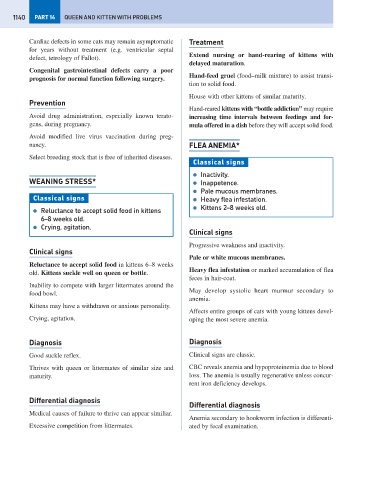Page 1148 - Problem-Based Feline Medicine
P. 1148
1140 PART 14 QUEEN AND KITTEN WITH PROBLEMS
Cardiac defects in some cats may remain asymptomatic Treatment
for years without treatment (e.g. ventricular septal
Extend nursing or hand-rearing of kittens with
defect, tetrology of Fallot).
delayed maturation.
Congenital gastrointestinal defects carry a poor
Hand-feed gruel (food–milk mixture) to assist transi-
prognosis for normal function following surgery.
tion to solid food.
House with other kittens of similar maturity.
Prevention
Hand-reared kittens with “bottle addiction” may require
Avoid drug administration, especially known terato- increasing time intervals between feedings and for-
gens, during pregnancy. mula offered in a dish before they will accept solid food.
Avoid modified live virus vaccination during preg-
nancy. FLEA ANEMIA*
Select breeding stock that is free of inherited diseases.
Classical signs
● Inactivity.
WEANING STRESS* ● Inappetence.
● Pale mucous membranes.
Classical signs ● Heavy flea infestation.
● Kittens 2–8 weeks old.
● Reluctance to accept solid food in kittens
6–8 weeks old.
● Crying, agitation.
Clinical signs
Progressive weakness and inactivity.
Clinical signs
Pale or white mucous membranes.
Reluctance to accept solid food in kittens 6–8 weeks
Heavy flea infestation or marked accumulation of flea
old. Kittens suckle well on queen or bottle.
feces in hair-coat.
Inability to compete with larger littermates around the
May develop systolic heart murmur secondary to
food bowl.
anemia.
Kittens may have a withdrawn or anxious personality.
Affects entire groups of cats with young kittens devel-
Crying, agitation. oping the most severe anemia.
Diagnosis Diagnosis
Good suckle reflex. Clinical signs are classic.
Thrives with queen or littermates of similar size and CBC reveals anemia and hypoproteinemia due to blood
maturity. loss. The anemia is usually regenerative unless concur-
rent iron deficiency develops.
Differential diagnosis
Differential diagnosis
Medical causes of failure to thrive can appear similiar.
Anemia secondary to hookworm infection is differenti-
Excessive competition from littermates. ated by fecal examination.

